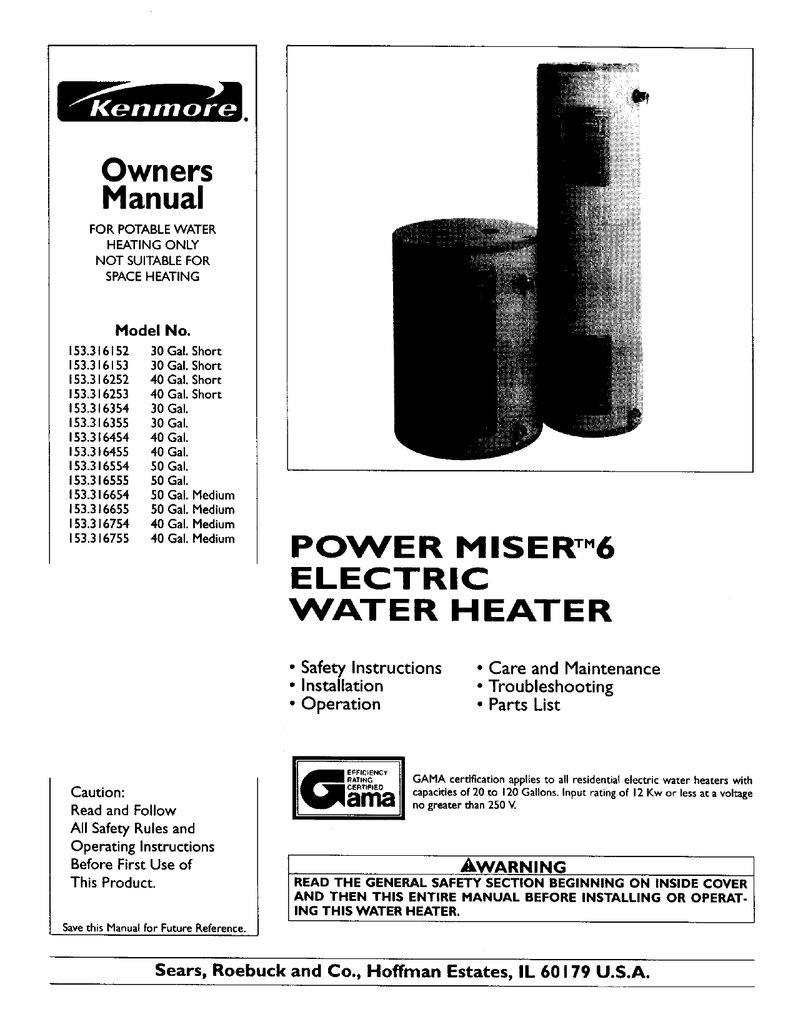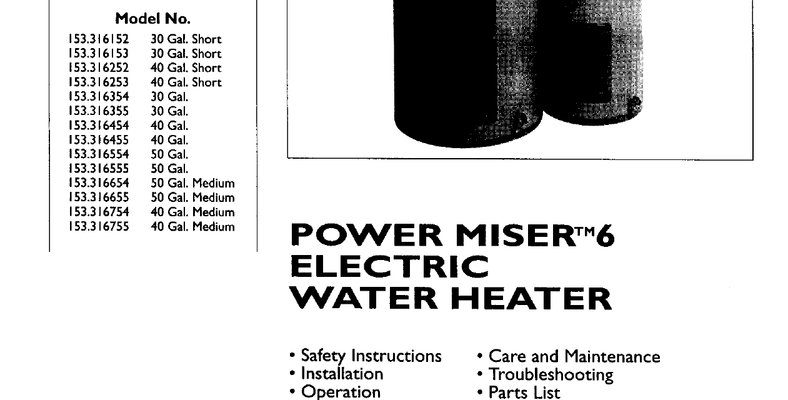
Maybe your heater is making strange noises, the pilot won’t stay lit, or it just quit without warning. Now, you’re left wondering: Will Kenmore cover this? Is there some magic code or trick to unlocking support? Don’t worry—I’ve done the digging for you, and I’ll walk you through where to track down that all-important warranty policy (and how to actually use it without feeling lost). Let’s talk comfy showers, peace of mind, and how much help you can expect when your Kenmore water heater acts up.
Understanding Kenmore Water Heater Warranties
Here’s the thing: the word “warranty” can sound official and intimidating, but at its core, it’s just Kenmore’s promise about their water heater’s reliability (within a certain timeframe and under certain conditions). Every Kenmore water heater comes with its own warranty policy, which lays out exactly what’s covered—like parts, the tank, or maybe even full unit replacement—and for how long. If you’ve never had to deal with warranties before, think of it as an insurance policy you didn’t have to buy separately.
Most Kenmore water heaters include coverage for specific issues like leaks, faulty components, or tank failures. The length and details of the warranty will vary depending on your model. Some heaters boast a generous 12-year tank warranty; others might offer five or six. That difference can mean the world when a part fails or a leak develops just after year six. This is why it matters so much to know what you’re actually covered for.
You might be wondering why the warranty details aren’t front and center. The truth is, Kenmore water heaters have been sold under different models and through different manufacturers over the years (like Sears, State, or A.O. Smith). So, the warranty info isn’t always found in one tidy place. Sometimes it’s tucked away in your owner’s manual, other times it’s online, or, in some rare cases, you might actually need to contact customer support directly. Knowing how to find the right policy means you’ll save hours of searching when you need answers most.
Locating Your Kenmore Water Heater’s Warranty Policy
Let me explain how this typically goes: You’re trying to figure out if a repair will be covered, so you search for “Kenmore water heater warranty policy” and get a bunch of results—some helpful, others hopelessly vague. Don’t worry; there are a few proven places to start your search.
Check your owner’s manual first. The original manual almost always includes a dedicated section on warranty policy, laying out what’s covered, what voids your warranty, and how to file a claim. If you can’t find the paper copy, don’t panic—most manuals are available as free downloads online.
- Search for your model number (usually on a label near the base, side, or inside the water heater access panel).
- Google “Kenmore water heater manual [model number] PDF” for a quick download.
- Within the manual, look for keywords like “warranty,” “guarantee,” or “service contract.”
If that’s not getting you anywhere, the next best spot is the Kenmore/Sears product support website. They provide access to manuals, warranty details, and troubleshooting guides by entering your model or serial number. Sometimes, these pages even include quick claim forms or helplines.
And if you’re still coming up empty, don’t underestimate calling customer support. Talking to a real person can get you info that’s impossible to find online, especially for older or discontinued Kenmore models. Sure, the hold music might not be thrilling, but direct answers are worth the wait.
What’s Actually Covered Under the Kenmore Water Heater Warranty?
It’s easy to assume all warranties are created equal, but the reality is, coverage can vary based on your water heater’s age, model, and even how it was installed. Let’s break it down, so you’re not caught off guard.
Most standard Kenmore policies cover:
- The tank itself (against leaks and ruptures) for anywhere from 6 to 12 years.
- Important working parts—like thermostats, heating elements, or gas valves—usually for a shorter period, like 1–6 years.
- Labor, but only in the first year or two. After that, replacement parts might be free, but installation or service calls usually aren’t.
Here’s where things get a little tricky: your warranty might require you to use authorized service pros, keep up with maintenance, or hang on to original receipts. If, for example, a part fails because your heater wasn’t installed properly, coverage could be voided—no matter how new the unit is.
The details are key. If you’re not sure what’s included, use that model number and manual to look for a warranty summary chart or call support to have them walk you through it, line by line. I always tell people: better to ask too many questions now than to be surprised by a bill later.
Online Resources: Where to Find Warranty Information Fast
If you’re in a hurry and need to find the warranty policy for your Kenmore water heater right now, digital tools are your friend. These days, the most reliable info lives online, though it may take a little navigation.
Start with the official Sears or Kenmore support website. They have a dedicated portal where you can type in your product’s model or serial number and pull up manuals, policy PDFs, and even warranty claim instructions. Just be sure to enter the number exactly as it appears on your water heater’s label.
- If you bought your unit at Sears, check your Sears.com account order history—sometimes warranty paperwork is saved right there.
- Many water heater brands, including Kenmore, have their own customer portal for warranty registration, troubleshooting, or service scheduling. If you registered your heater during installation, your warranty policy might be attached to your account.
- Don’t forget reputable third-party appliance sites (like ManualsLib) where you can quickly search for your specific model’s documents.
While you’re there, take note of any warranty codes, claim procedures, or expiration dates. Screenshots can be a lifesaver if you need proof later. Just remember, the specifics sometimes change (especially if Kenmore retires a product line), so double-check the date on any policy PDF or online listing.
How to File a Warranty Claim for Your Kenmore Water Heater
Once you have the policy, the next step is actually using it. Filing a claim isn’t as complicated as it sounds, but skipping a step or missing paperwork can lead to delays. Here’s how most Kenmore warranty claims work, step by step:
- Gather your essentials: You’ll need the model and serial number (on the product label), a dated proof of purchase, and, if possible, the original warranty certificate. Some claims ask for photos of the unit or damaged part.
- Contact Kenmore or the warranty administrator directly. Use the phone number or claim portal listed in your manual or on the official website. Be ready to describe the issue clearly—like, “The pilot won’t stay lit” or “Tank is leaking from the bottom.”
- Follow their troubleshooting steps. Honestly, many times they’ll ask you to do basic troubleshooting over the phone or email (resetting the heater, checking the code, testing the battery for digital controls, etc.). If you’re not comfortable with technical steps, don’t hesitate to say so.
- Schedule authorized service if approved. If the issue is covered, Kenmore will usually send a qualified technician. Keep all receipts and documentation in case you need follow-up service or reimbursement.
Let me share a little tip: if your model is older or if Kenmore no longer carries your exact part, you may be offered a universal or compatible substitute. Sometimes this requires extra “pairing” or setup—so ask questions about code compatibility and installation before agreeing.
Comparing Kenmore Warranty Policies: Pros and Cons
Not all warranties are equal, and knowing where Kenmore stands compared to other brands can help set your expectations. Kenmore water heater warranties are generally pretty reliable, but there are some quirks.
What Kenmore does well:
- Clear coverage on the tank itself (often longer than off-brand alternatives).
- Decent support for common troubleshooting questions, especially if you buy through Sears.
- Documentation for most mainstream models is easy to find if you know where to look.
Potential drawbacks:
- If Kenmore changes suppliers or your specific model is discontinued, getting original parts can be trickier—and sometimes the warranty is handled by a third party.
- Labor coverage is usually limited to the first year or two, unlike some “bigger name” brands that may offer more generous labor terms.
- Universal water heater warranties are sometimes available for non-Kenmore-branded models, but you’ll lose out on OEM compatibility and easy troubleshooting support.
Honestly, the best advice is to read your own model’s policy closely and ask about coverage details before committing to any repairs or replacement parts.
Registering Your Warranty—and Why It Matters
You might be wondering: “If I never registered my water heater, am I out of luck?” Here’s the good news—most Kenmore warranties start from the date of purchase, not the registration date. But, registering can make your life much easier if (or when) something does go wrong.
Why registration helps:
- It puts your info in Kenmore’s system, speeding up future troubleshooting and claims.
- Some promotions or extended warranty options are only available if you register within a certain window.
- It acts as a backup if you lose your receipt or proof of purchase.
Registration is usually quick: just visit the Kenmore warranty site, enter your serial/model number, upload your receipt, and fill out a short form. If you skipped this step, don’t stress—it just means you’ll need to provide your purchase proof the old-fashioned way during a claim.
Reading the Fine Print: Warranty Exclusions and Limitations
Here’s where a lot of people get tripped up. The warranty policy for any Kenmore water heater comes with exclusions—stuff that’s not covered, even if your unit is less than a year old. Don’t get caught off guard by the details.
Typical exclusions include:
- Problems caused by improper installation or unauthorized repairs.
- Damage from hard water, neglect, or failure to complete regular maintenance (like flushing the tank).
- Cosmetic issues, or natural wear and tear that doesn’t affect function.
- Damage from external events: floods, earthquakes, or power surges.
If you run into a problem and your claim is denied, always ask the representative for a full explanation—and double-check your manual to confirm. Sometimes, what seems like a “code” or technicality is just buried in the fine print.
A little legwork upfront—like reading what voids your warranty or learning how to reset or troubleshoot your unit—can save you a lot of frustration (and money) later on.
Wrapping Up: Find Peace of Mind with the Right Warranty Info
Like finally finding that hidden light switch, knowing exactly where to find the warranty policy for your Kenmore water heater brings a certain peace of mind. Whether you’re fixing a minor issue or dealing with a total outage, having your warranty details handy makes the whole process clearer and a lot less stressful. From digging out the manual to navigating the Kenmore support site, or even calling a real person for help, you’ve got more options than you think.
Don’t be afraid to ask questions, double-check the details, or even push for troubleshooting support if something’s not working. At the end of the day, a warranty isn’t just a piece of paperwork—it’s an extra layer of confidence that someone’s got your back when your hot water decides to quit. So keep your model number close, bookmark those manuals, and rest a little easier knowing you’re covered.
